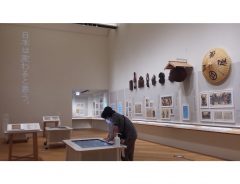
Source: © PR Times, Inc.
“Ainu Museum” dedicated to the indigenous people of North Japan to open this spring
- Tags:
- Ainu / Ainu culture / Ainu people / Museum / Upopoy National Ainu Museum and Park
Related Article
-

Japanese Bamboo Art Captivates Western Collectors and the World
-

Celebrate Space Day With Black Hole Seafood Bowls And Galaxy Parfaits!
-

The Fascinating Memorial Museum for Soldiers, Detainees in Siberia, and Post-war Repatriates
-

New Toilet Museum In Japan Shows Us The History Of Restrooms And…Urinals For Women And Toilet Bikes?! Look Inside Here.
-

How we became modern: a trip to Tokyo Advertising Museum
-

Japan’s museum art display bag are perfect for showing off your favorite anime character


April 2020 will see the unveiling of the Upopoy National Ainu Museum and Park in Hokkaido. The museum will open in Shirai, Hokkaido to celebrate the history of the Ainu, Japan’s indigenous people and to help preserve their culture, which is sadly disappearing.
The venue will be Hokkaido’s first national museum, Japan’s most northern national museum and the first museum committed to the Ainu people. The Upopoy Museum claims that their aim and mission will be “to promote a proper understanding and awareness of Ainu history and culture in Japan and elsewhere out of respect for the dignity of the indigenous Ainu people while contributing to the creation and development of new aspects of Ainu culture.” The museum states that in addition to the focus on Ainu culture, they wish to highlight various parts of contemporary Ainu culture.
The name chosen for the museum, Upopoy, means “singing in a large group”, symbolizing the connection the museum wants to make between visitors and the Ainu.
The museum will be situated next to Lake Poroto in Shirai, and will have two main areas: the National Ainu Museum and the National Ainu Park.
The museum will display permanent exhibitions across two floors about Ainu culture, language, heritage, and both historical and daily life. In addition to the permanent displays, the museum will also have an area dedicated to special time-limited exhibits. The main areas inside the venue will include an introduction to Ainu, a historical artifact exhibit, an interactive zone where visitors are introduced to traditional Ainu tools and a theatre showing short documentary films on Ainu culture. Information in the museum will be available in Japanese, English and Ainu.
The venue’s second area, the National Ainu Park, will be an interactive open-air museum, focusing on the immersion of visitors into Ainu culture, which has been cultivated amidst nature for centuries. Situated at the edge of a dense forest and on the edge of Lake Poroto, the park allows visitors to learn about Ainu views of nature through classes dedicated to the appreciation of trees and vegetation.
The park will house the Kotan, a traditional Ainu village, where guests can explore typical Ainu housing and experience Ainu daily life.
In the park, visitors will be able to learn traditional Ainu cuisine through cooking and tasting activities, try out wood carving and embroidery using classic Ainu patterns, take part in traditional Ainu dance and enjoy the time-honoured sound of typical Ainu musical instruments, the mukkuri and tonkori. In addition to all the experiences available at the park, special classes on Ainu culture and history will also be available for children where they can take part in traditional Ainu games.
Ashley Van Haeften | © Flickr.com
A restaurant and food court with views overlooking Lake Poroto will be available on-site where visitors can enjoy meals chosen from a large menu. Near the restaurant, the venue’s shop will sell light lunches and drinks as well as Ainu crafts and items.
The museum is set to open on April 24 2020, and will be easily accessed by a limited-express train from Sapporo in 65 minutes, and in 40 minutes by limited express train from New Chitose Airport.